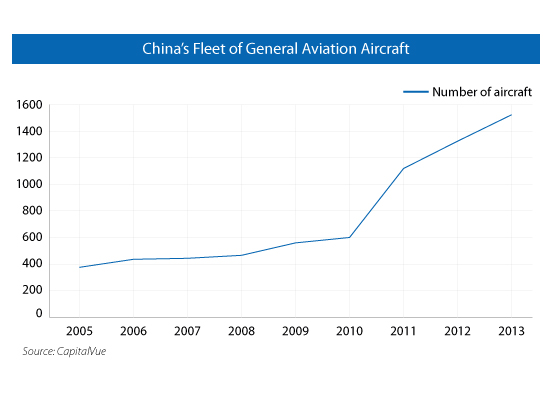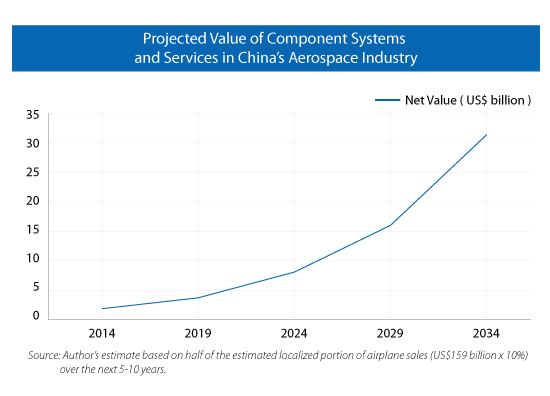Investing in China’s Aerospace and Aviation Industry
By Roy K. McCall
China is already the second largest air travel market in the world, leading to considerable opportunities for foreign investment in the country’s aerospace and aviation industry. Over the next five to ten years, China will increase the size of its general aviation fleet by roughly 30 percent annually, a total value of $159 billion, according to PIM Ltd. From 2012-2032, Chinese enterprises and individuals are expected to purchase 5,357 aircraft of at least 50 seats apiece, at a net worth of US$647 billion; the number of single-aisle jet airliners will account for 75 percent of this total.

The Civil Aviation Administration of China mandates that foreign investors may not produce planes in China except through co-ventures with AVIC (Aviation Industry Corporation of China, owner of the XAC/Xi’an Aircraft Corporation) and COMAC (Commercial Aircraft Corporation of China). China currently assembles final-stage versions of the Airbus A320 and produces the Embraer ERJ-145 regional jet under license.
Additionally, plans are in the works for the manufacture of two medium-size domestic planes: AVIC/XAC’s MA60 turboprop and COMAC’s 90-seat ARJ21 regional jet. COMAC is also developing a 190-seat passenger aircraft, the C919, with the goal of completely displacing the market share of the aging Boeing 737 and Airbus 320 in China.
While all wide-body aircraft will be imported through 2020, AVIC SAC Commercial Aircraft Co., Ltd. (SACC) continues to produce the front edge of the vertical tail of the B787 aircraft, serving as the sole Tier 1 supplier since 2007. As for the A330/340, since 2004-2005, SACC has been making forward & aft cargo doors, currently at a rate of eight and six per month, respectively.
Foreign investors are more likely to find opportunities in China’s aerospace and aviation industry through component systems (engines, hydraulics and electronics) and services (design engineering, precision machining and training), which will be worth at least $8 billion over the next five to ten years, or more than $32 billion over the next 20 years.

This is despite the fact that global aerospace component sales fell below $400 million in the most recent fiscal year (2013), mainly due to a $100 million drop off in business with the U.S. Rising costs in China require a commensurate rise in quality – an ongoing challenge to prospective investors.
Within China however, with AVIC and COMAC setting the priorities for the market, demand may increase in areas of engine design and development, as evidenced by GE Aviation, Pratt & Whitney, Rolls-Royce and MTU Aero Engines GmbH having committed to participate in upcoming forums with AVIC and COMAC.
Led by companies such as PPG, Huntsman and Japan’s Toyo and Mitsubishi Rayon, composite materials (e.g. carbon fiber) might also become a topical and accessible industry – especially in light of the Chinese government’s recent decision to expand its aerospace force and the rising demand for new technologies carried onboard projects such as the Gaofen high-resolution satellites.
But given China’s record with intellectual property rights protection, some firms with a competitive edge may be cautious about transferring first generation technologies into the country. While some degree of reverse engineering is unavoidable, investors whose operations combine both innovation and superior services will lead the way to safer, cheaper and more convenient travel for all.
Roy K. McCall CFA/CPA previously worked as an interim manager at Magellan Aerospace (MAL.TO), a supplier to Airbus, Boeing, Pratt & Whitney Canada and others. He has provided strategic M&A advice to two other aerospace component and service firms.
CapitalVue is a Greater China-centric data and information provider servicing global institutional investors, investment banks, government organizations, and corporations, with critical real-time capital market (Equities, Funds, Fixed Income, Index), fundamental, and time-series statistical databases, with the speed, depth and breadth institutions require
Asia Briefing Ltd. is a subsidiary of Dezan Shira & Associates. Dezan Shira is a specialist foreign direct investment practice, providing corporate establishment, business advisory, tax advisory and compliance, accounting, payroll, due diligence and financial review services to multinationals investing in China, Hong Kong, India, Vietnam, Singapore and the rest of ASEAN. For further information, please email china@dezshira.com or visit www.dezshira.com.
Stay up to date with the latest business and investment trends in Asia by subscribing to our complimentary update service featuring news, commentary and regulatory insight.
Related Reading
 Revisiting the Shanghai Free Trade Zone: A Year of Reforms
Revisiting the Shanghai Free Trade Zone: A Year of Reforms
In this issue of China Briefing, we revisit the Shanghai FTZ and its preferential environment for foreign investment. In the first three articles, we highlight the many changes that have been introduced in the Zone’s first year of operations, including the 2014 Revised Negative List, as well as new measures relating to alternative dispute resolution, cash pooling, and logistics. Lastly, we include a case study of a foreign company successfully utilizing the Shanghai FTZ to access the Outbound Tourism Industry.
 Adapting Your China WFOE to Service China’s Consumers
Adapting Your China WFOE to Service China’s Consumers
In this issue of China Briefing Magazine, we look at the challenges posed to manufacturers amidst China’s rising labor costs and stricter environmental regulations. Manufacturing WFOEs in China should adapt by expanding their business scope to include distribution and determine suitable supply chain solutions. In this regard, we will take a look at the opportunities in China’s domestic consumer market and forecast the sectors that are set to boom in the coming years.
 Industry Specific Licenses and Certifications in China
Industry Specific Licenses and Certifications in China
In this issue of China Briefing, we provide an overview of the licensing schemes for industrial products; food production, distribution and catering services; and advertising. We also introduce two important types of certification in China: the CCC and the China Energy Label (CEL). This issue will provide you with an understanding of the requirements for selling your products or services in China.
- Previous Article Logistics in the Shanghai Free Trade Zone
- Next Article Case Study: Using the Shanghai FTZ to Access the Outbound Tourism Industry
























